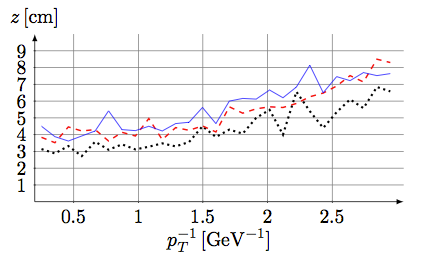Neural Networks for Triggering
October 12, 2014 at 2:16 pm Leave a comment
As experiments push the high-energy frontier, and also the intensity frontier, they must contend with higher and higher instantaneous luminosities. This challenge drives experimenters to try new techniques for triggering that might have sounded outlandish or fanciful ten years ago.
The Belle II experiment posted a paper this week on using (artificial) neural networks at the first trigger level for their experiment (arXiv:1410.1395). To be explicit: they plan to implement an artificial neural network at the hardware-trigger level, L1, i.e., the one that deals with the most primitive information from the detector in real time. The L1 latency is 5 μs which allows only 1 μs for the trigger decision.
At issue is a major background coming from Touschek scattering. The coulomb interaction of the e- and e+ beams can transform a small transverse phase space into a long longitudinal phase space. (See a DESY report 98-179 for a discussion.) The beam is thereby spread out in the z direction leading to collisions taking place far from the center of the apparatus. This is a bad thing for analysis and for triggering since much of the event remains unreconstructed — such events are a waste of bandwidth. The artificial neural networks, once trained, are mechanistic and parallel in the way they do their calculations, therefore they are fast – just what is needed for this situation. The interesting point is that here, in the Belle application, decisions about the z position of the vertex will be made without reconstructing any tracks (because there is insufficient time to carry out the reconstruction).
The CDC has 56 axial and stereo layers grouped into nine superlayers. Track segments are found by the TSF based on superlayer information. The 2D trigger module finds crude tracks in the (r,φ) plane. The proposed neutral network trigger takes information from the axial and stereo TSF, and also from the 2D trigger module.
As usual, the artificial neural network is based on the multi-layer perceptron (MLP) with a hyperbolic tangent activation function. The network is trained by back-propagation. Interestingly, the authors use an ensemble of “expert” MLPs corresponding to small sectors in phase space. Each MLP is trained on a subset of tracks corresponding to that sector. Several incarnations of the network were investigated, which differ in the precise information used as input to the neural network. The drift times are scaled and the left/right/undecided information is represented by an integer. The azimuthal angle can be represented by a scaled wire ID or by an angle relative to the one produced by the 2D trigger. There is a linear relation between the arc length and the z coordinate, so the arc length (μ) can also be a useful input variable.
As a first test, one sector is trained for a sample of low-pT and another sample of high-pT tracks. The parameter range is very constrained, and the artificial neural networks do well, achieving a resolution of 1.1 – 1.8 cm.
In a second test, closer to the planned implementation, the output of the 2D trigger is represented by some smeared φ and pT values. The track parameters cover a wider range than in the first test, and the pT range is divided into nine pieces. The precision is 3 – 7cm in z, which is not yet good enough for the application (they are aiming for 2 cm or better). Nonetheless, this estimate is useful because it can be used to restrict the sector size for the next step.
Clearly this is a work in progress, and much remains to be done. Assuming that the Belle Collaboration succeeds, the fully pipelined neural network trigger will be realized on FPGA boards.
Entry filed under: Particle Physics.


Trackback this post | Subscribe to the comments via RSS Feed